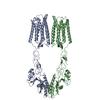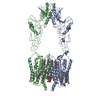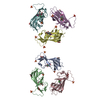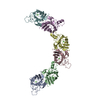+ Open data
Open data
- Basic information
Basic information
| Entry | Database: EMDB / ID: EMD-31351 | ||||||||||||
|---|---|---|---|---|---|---|---|---|---|---|---|---|---|
| Title | apo GPR158 | ||||||||||||
 Map data Map data | |||||||||||||
 Sample Sample |
| ||||||||||||
 Keywords Keywords | Class C orphan GPCR / depression / neuronal signaling / PAS-folded GPCR / noncanonical signaling GPCR / signaling protein | ||||||||||||
| Function / homology |  Function and homology information Function and homology informationG protein-coupled glycine receptor activity / regulation of G protein-coupled receptor signaling pathway / positive regulation of neurotransmitter secretion / regulation of synapse organization / enzyme activator activity / protein localization to plasma membrane / cell projection / postsynaptic density membrane / brain development / cognition ...G protein-coupled glycine receptor activity / regulation of G protein-coupled receptor signaling pathway / positive regulation of neurotransmitter secretion / regulation of synapse organization / enzyme activator activity / protein localization to plasma membrane / cell projection / postsynaptic density membrane / brain development / cognition / transmembrane signaling receptor activity / presynaptic membrane / postsynaptic membrane / G protein-coupled receptor signaling pathway / nucleus / plasma membrane Similarity search - Function | ||||||||||||
| Biological species |  Homo sapiens (human) Homo sapiens (human) | ||||||||||||
| Method | single particle reconstruction / cryo EM / Resolution: 3.52 Å | ||||||||||||
 Authors Authors | Jeong E / Kim Y | ||||||||||||
| Funding support |  Korea, Republic Of, 3 items Korea, Republic Of, 3 items
| ||||||||||||
 Citation Citation |  Journal: Nat Commun / Year: 2021 Journal: Nat Commun / Year: 2021Title: Structure of the class C orphan GPCR GPR158 in complex with RGS7-Gβ5. Authors: Eunyoung Jeong / Yoojoong Kim / Jihong Jeong / Yunje Cho /  Abstract: GPR158, a class C orphan GPCR, functions in cognition, stress-induced mood control, and synaptic development. Among class C GPCRs, GPR158 is unique as it lacks a Venus flytrap-fold ligand-binding ...GPR158, a class C orphan GPCR, functions in cognition, stress-induced mood control, and synaptic development. Among class C GPCRs, GPR158 is unique as it lacks a Venus flytrap-fold ligand-binding domain and terminates Gαi/o protein signaling through the RGS7-Gβ5 heterodimer. Here, we report the cryo-EM structures of GPR158 alone and in complex with one or two RGS7-Gβ5 heterodimers. GPR158 dimerizes through Per-Arnt-Sim-fold extracellular and transmembrane (TM) domains connected by an epidermal growth factor-like linker. The TM domain (TMD) reflects both inactive and active states of other class C GPCRs: a compact intracellular TMD, conformations of the two intracellular loops (ICLs) and the TMD interface formed by TM4/5. The ICL2, ICL3, TM3, and first helix of the cytoplasmic coiled-coil provide a platform for the DHEX domain of one RGS7 and the second helix recruits another RGS7. The unique features of the RGS7-binding site underlie the selectivity of GPR158 for RGS7. | ||||||||||||
| History |
|
- Structure visualization
Structure visualization
| Movie |
 Movie viewer Movie viewer |
|---|---|
| Structure viewer | EM map:  SurfView SurfView Molmil Molmil Jmol/JSmol Jmol/JSmol |
| Supplemental images |
- Downloads & links
Downloads & links
-EMDB archive
| Map data |  emd_31351.map.gz emd_31351.map.gz | 8.1 MB |  EMDB map data format EMDB map data format | |
|---|---|---|---|---|
| Header (meta data) |  emd-31351-v30.xml emd-31351-v30.xml emd-31351.xml emd-31351.xml | 9.8 KB 9.8 KB | Display Display |  EMDB header EMDB header |
| Images |  emd_31351.png emd_31351.png | 99.4 KB | ||
| Filedesc metadata |  emd-31351.cif.gz emd-31351.cif.gz | 5.2 KB | ||
| Archive directory |  http://ftp.pdbj.org/pub/emdb/structures/EMD-31351 http://ftp.pdbj.org/pub/emdb/structures/EMD-31351 ftp://ftp.pdbj.org/pub/emdb/structures/EMD-31351 ftp://ftp.pdbj.org/pub/emdb/structures/EMD-31351 | HTTPS FTP |
-Validation report
| Summary document |  emd_31351_validation.pdf.gz emd_31351_validation.pdf.gz | 354.4 KB | Display |  EMDB validaton report EMDB validaton report |
|---|---|---|---|---|
| Full document |  emd_31351_full_validation.pdf.gz emd_31351_full_validation.pdf.gz | 354 KB | Display | |
| Data in XML |  emd_31351_validation.xml.gz emd_31351_validation.xml.gz | 6.4 KB | Display | |
| Data in CIF |  emd_31351_validation.cif.gz emd_31351_validation.cif.gz | 7.4 KB | Display | |
| Arichive directory |  https://ftp.pdbj.org/pub/emdb/validation_reports/EMD-31351 https://ftp.pdbj.org/pub/emdb/validation_reports/EMD-31351 ftp://ftp.pdbj.org/pub/emdb/validation_reports/EMD-31351 ftp://ftp.pdbj.org/pub/emdb/validation_reports/EMD-31351 | HTTPS FTP |
-Related structure data
| Related structure data |  7ewlMC  7ewpC  7ewrC M: atomic model generated by this map C: citing same article ( |
|---|---|
| Similar structure data |
- Links
Links
| EMDB pages |  EMDB (EBI/PDBe) / EMDB (EBI/PDBe) /  EMDataResource EMDataResource |
|---|---|
| Related items in Molecule of the Month |
- Map
Map
| File |  Download / File: emd_31351.map.gz / Format: CCP4 / Size: 113.6 MB / Type: IMAGE STORED AS FLOATING POINT NUMBER (4 BYTES) Download / File: emd_31351.map.gz / Format: CCP4 / Size: 113.6 MB / Type: IMAGE STORED AS FLOATING POINT NUMBER (4 BYTES) | ||||||||||||||||||||||||||||||||||||||||||||||||||||||||||||
|---|---|---|---|---|---|---|---|---|---|---|---|---|---|---|---|---|---|---|---|---|---|---|---|---|---|---|---|---|---|---|---|---|---|---|---|---|---|---|---|---|---|---|---|---|---|---|---|---|---|---|---|---|---|---|---|---|---|---|---|---|---|
| Projections & slices | Image control
Images are generated by Spider. | ||||||||||||||||||||||||||||||||||||||||||||||||||||||||||||
| Voxel size | X=Y=Z: 0.83 Å | ||||||||||||||||||||||||||||||||||||||||||||||||||||||||||||
| Density |
| ||||||||||||||||||||||||||||||||||||||||||||||||||||||||||||
| Symmetry | Space group: 1 | ||||||||||||||||||||||||||||||||||||||||||||||||||||||||||||
| Details | EMDB XML:
CCP4 map header:
| ||||||||||||||||||||||||||||||||||||||||||||||||||||||||||||
-Supplemental data
- Sample components
Sample components
-Entire : GPR158
| Entire | Name: GPR158 |
|---|---|
| Components |
|
-Supramolecule #1: GPR158
| Supramolecule | Name: GPR158 / type: complex / ID: 1 / Parent: 0 / Macromolecule list: all |
|---|---|
| Source (natural) | Organism:  Homo sapiens (human) Homo sapiens (human) |
| Molecular weight | Theoretical: 200 kDa/nm |
-Macromolecule #1: Probable G-protein coupled receptor 158
| Macromolecule | Name: Probable G-protein coupled receptor 158 / type: protein_or_peptide / ID: 1 / Number of copies: 2 / Enantiomer: LEVO |
|---|---|
| Source (natural) | Organism:  Homo sapiens (human) Homo sapiens (human) |
| Molecular weight | Theoretical: 77.462703 KDa |
| Recombinant expression | Organism:  Homo sapiens (human) Homo sapiens (human) |
| Sequence | String: ASRDPQGRPD SPRERTPKGK PHAQQPGRAS ASDSSAPWSR STDGTILAQK LAEEVPMDVA SYLYTGDSHQ LKRANCSGRY ELAGLPGKW PALASAHPSL HRALDTLTHA TNFLNVMLQS NKSREQNLQD DLDWYQALVW SLLEGEPSIS RAAITFSTDS L SAPAPQVF ...String: ASRDPQGRPD SPRERTPKGK PHAQQPGRAS ASDSSAPWSR STDGTILAQK LAEEVPMDVA SYLYTGDSHQ LKRANCSGRY ELAGLPGKW PALASAHPSL HRALDTLTHA TNFLNVMLQS NKSREQNLQD DLDWYQALVW SLLEGEPSIS RAAITFSTDS L SAPAPQVF LQATREESRI LLQDLSSSAP HLANATLETE WFHGLRRKWR PHLHRRGPNQ GPRGLGHSWR RKDGLGGDKS HF KWSPPYL ECENGSYKPG WLVTLSSAIY GLQPNLVPEF RGVMKVDINL QKVDIDQCSS DGWFSGTHKC HLNNSECMPI KGL GFVLGA YECICKAGFY HPGVLPVNNF RRRGPDQHIS GSTKDVSEEA YVCLPCREGC PFCADDSPCF VQEDKYLRLA IISF QALCM LLDFVSMLVV YHFRKAKSIR ASGLILLETI LFGSLLLYFP VVILYFEPST FRCILLRWAR LLGFATVYGT VTLKL HRVL KVFLSRTAQR IPYMTGGRVM RMLAVILLVV FWFLIGWTSS VCQNLEKQIS LIGQGKTSDH LIFNMCLIDR WDYMTA VAE FLFLLWGVYL CYAVRTVPSA FHEPRYMAVA VHNELIISAI FHTIRFVLAS RLQSDWMLML YFAHTHLTVT VTIGLLL IP KFSHSSNNPR DDIATEAYED ELDMGRSGSY LNSSINSAWS EHSLD UniProtKB: Metabotropic glycine receptor |
-Experimental details
-Structure determination
| Method | cryo EM |
|---|---|
 Processing Processing | single particle reconstruction |
| Aggregation state | particle |
- Sample preparation
Sample preparation
| Concentration | 12.7 mg/mL |
|---|---|
| Buffer | pH: 7.5 |
| Vitrification | Cryogen name: ETHANE / Chamber humidity: 100 % |
- Electron microscopy
Electron microscopy
| Microscope | FEI TALOS ARCTICA |
|---|---|
| Image recording | Film or detector model: GATAN K3 (6k x 4k) / Average electron dose: 50.0 e/Å2 |
| Electron beam | Acceleration voltage: 200 kV / Electron source:  FIELD EMISSION GUN FIELD EMISSION GUN |
| Electron optics | Illumination mode: FLOOD BEAM / Imaging mode: DIFFRACTION |
| Experimental equipment |  Model: Talos Arctica / Image courtesy: FEI Company |
- Image processing
Image processing
| Startup model | Type of model: NONE |
|---|---|
| Final reconstruction | Number classes used: 1 / Resolution.type: BY AUTHOR / Resolution: 3.52 Å / Resolution method: FSC 0.143 CUT-OFF / Number images used: 425819 |
| Initial angle assignment | Type: OTHER |
| Final angle assignment | Type: OTHER |
 Movie
Movie Controller
Controller















 Z (Sec.)
Z (Sec.) Y (Row.)
Y (Row.) X (Col.)
X (Col.)





















